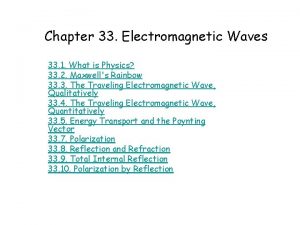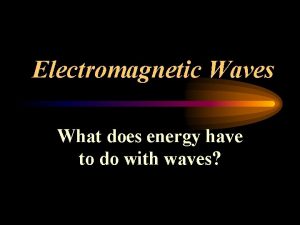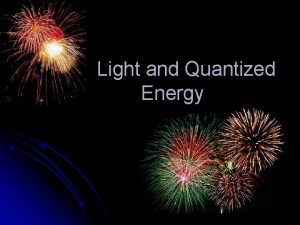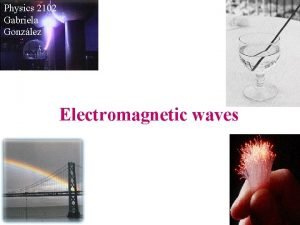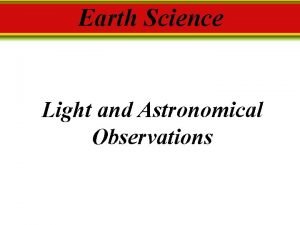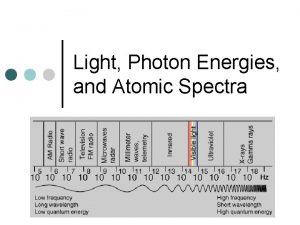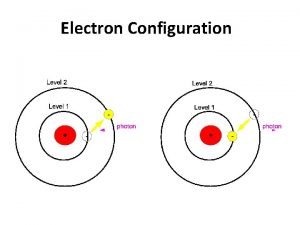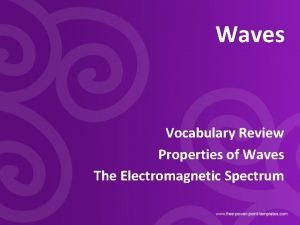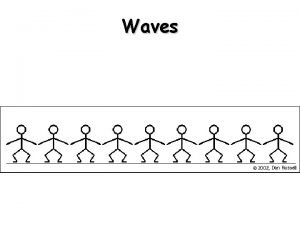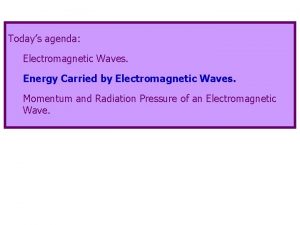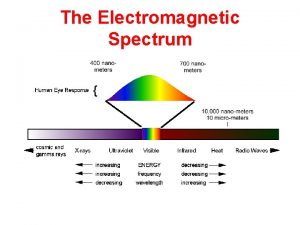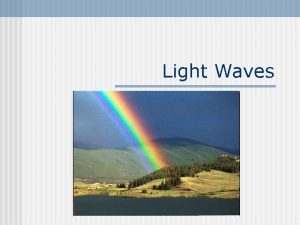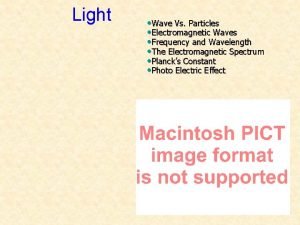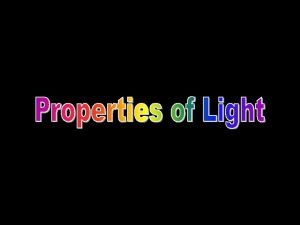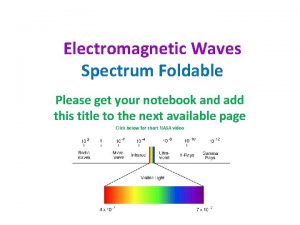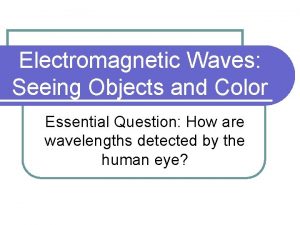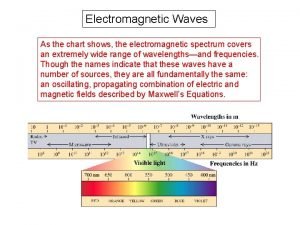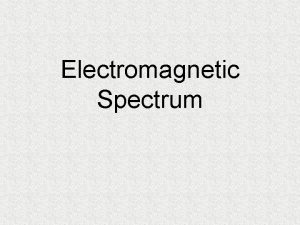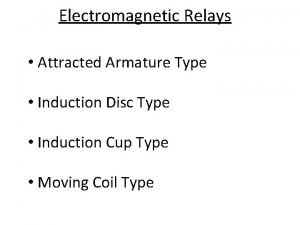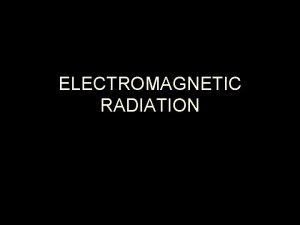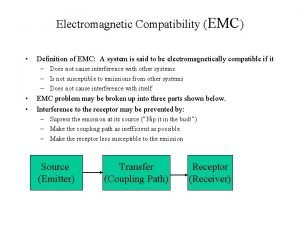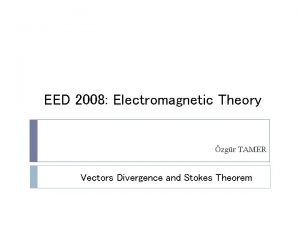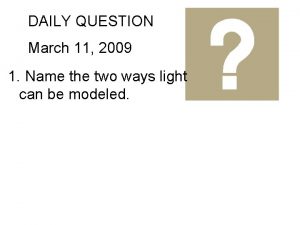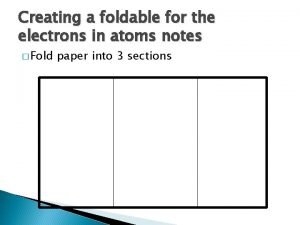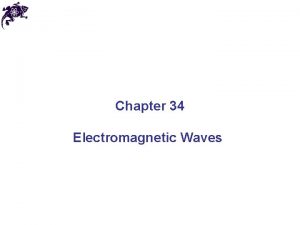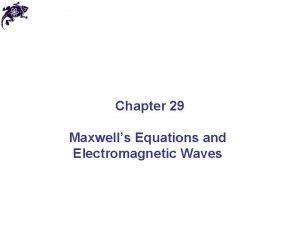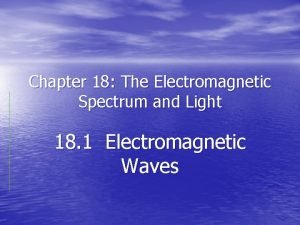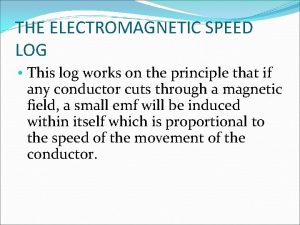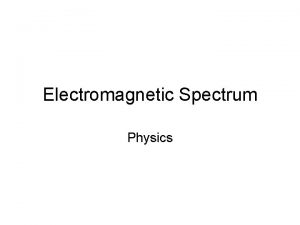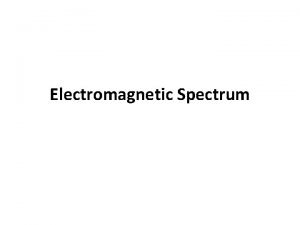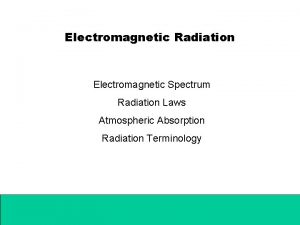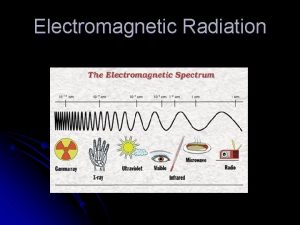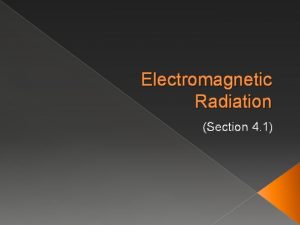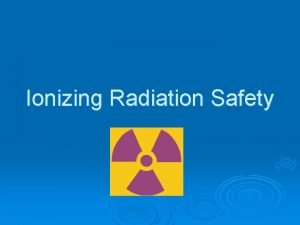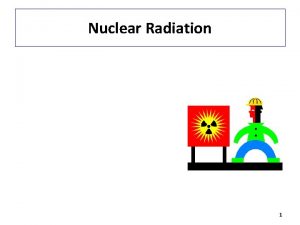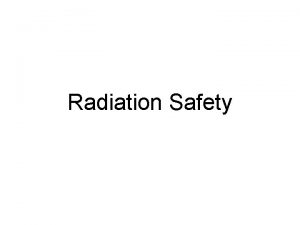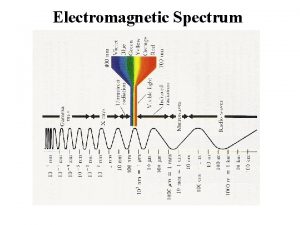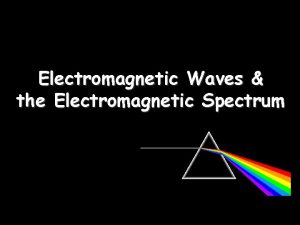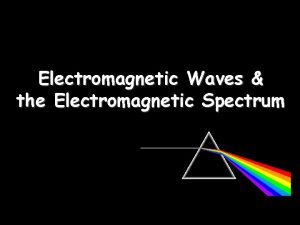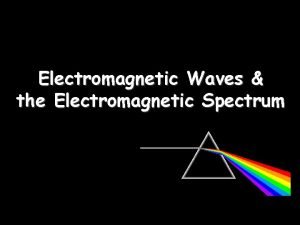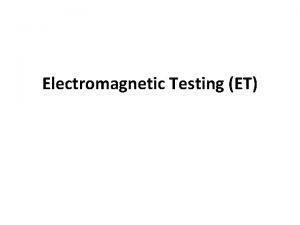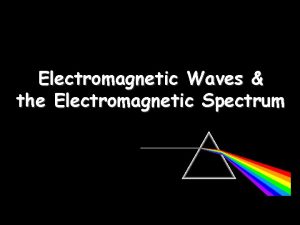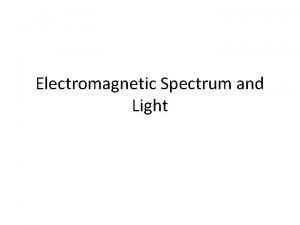Study Points What kind of electromagnetic radiation comes
























































- Slides: 56

Study Points • • • What kind of electromagnetic radiation comes from radioactive material? Is used to look at bones? Causes skin damage? Can you see? Feels warm & penetrates smoke & dust? Warms food? Can you hear? How much of the universe can you see with your eyes or a telescope? What is similar about these EM waves? What is different about these EM waves? State the two kinds of EM waves that go through Earth’s atmosphere? Given a type of EM wave, give some idea of the energy of the source of that EM wave. For example, does a radio wave come from a very energetic source or a medium energy source or a not so energetic source? Given a type of EM wave, give some idea of the temperature of the source of that EM wave. For example, does a radio wave come from a cool, a warm, or a hot source? Name and describe three types of spectra. Describe a source or process that produces each type of spectrum. Give a density description for each spectra type. Recognize that each element has a unique spectrum. What type of spectrum is produced by our Sun?

Spectra Radiation and Spectra Three types of spectra What we can learn from spectra

*Electromagnetic (EM) Spectrum Long λ Low f Low energy Visible ROY G. BIV (700 nm) (400 nm) Short λ High f High energy Ralph's Mother Is Visiting Uncle Xavier's Garden Radio Microwave Infrared Visible Ultraviolet X-ray Gamma Part of the above from http: //library. thinkquest. org/10380/advanced. shtml

Electromagnetic (EM) Spectrum Extremes Radar TV FM AM Shortest Wavelength Longest Wavelength 1 x 10 -20 m possibly up to 1011 m Ultra High Energy Gamma Rays Ultra Low Frequency Radio

Electromagnetic (EM) Waves Radar TV FM AM Gamma X-ray Ultraviolet Visible Infrared Microwave Radio

*Which type of EM wave is generated from radioactive materials? GAMMA RAYS or gamma radiation Radar TV FM AM • Gamma rays are used in medical PET scans. • Most gamma rays are generated from universe.

*Which type of EM wave is used to look at human bones? X-RAYS Radar TV FM AM • X-rays are used in airport security. • X-rays are emitted from hot gases in the universe.

*Which type of EM wave causes sunburn, skin cancer, cataracts? ULTRAVIOLET Radar TV FM AM • From “hot” objects in space (Sun and stars)

*Which type of EM wave can you see? VISIBLE Radar TV FM AM • From fireflies, light bulbs and stars

*Which type of EM wave feels warm? INFRARED Radar TV FM AM • • From our bodies and objects with heat Used in TV remote controls and night vision goggles *Penetrates smoke and dust Helps map dust between stars

*Which type of EM wave warms food? MICROWAVES Radar TV FM AM • Used to learn about the structure of nearby galaxies

*Which type of EM wave can you play on your car stereo? RADIO Radar TV FM AM • Frequency of most wireless devices • From stars and gases

Electromagnetic (EM) Waves Radar TV FM AM *All EM waves are less than 5% of the universe - this is everything we can see with our eyes or telescopes

ALL EM WAVES: • *Travel through the vacuum of space (sound cannot) • *Travel at the speed of light through the vacuum of space

ALL EM WAVES *Differ in: • λ • f • Energy • Temperature

Earth’s atmosphere absorbs most EM waves. *Lets through Radio & Visible the most (some UV & IR get through) http: //www. ipac. caltech. edu/outreach/Edu/Windows/irwindows. html

Looking with “other eyes” Ex: Newborn stars (IR) Spectra DR 21 6000 ly 75 ly Cygnus

Visible Infrared Spectra

Visible Near IR 938 nm Composite = IR + Visible 938 nm, 889 nm, 420 nm Green – surface Red – high atm, methane absorbs sunlight Blue – violet wavelengths for the haze Titan (moon of Saturn) – NASA/JPL

1. *To detect an EXTREMELY ENERGETIC event like two neutron stars merging, “look” for this kind of wave: 1. Radio 2. Micro 3. IR 4. Visible 5. UV 6. X-ray 7. Gamma

1. To detect an EXTREMELY ENERGETIC event like two neutron stars merging, “look” for this kind of wave: 1. Radio 2. Micro 3. IR 4. Visible 5. UV 6. X-ray 7. Gamma

2. *To detect a VERY LOW ENERGY event like the spin flip of a H atom, “look” for this kind of wave: 1. Radio 2. Micro 3. IR 4. Visible 5. UV 6. X-ray 7. Gamma

2. To detect a VERY LOW ENERGY event like the spin flip of a H atom, “look” for this kind of wave: 1. Radio 2. Micro 3. IR 4. Visible 5. UV 6. X-ray 7. Gamma

Spectra Waves carry energy, hence, information. λ (or color) tells you… Temperature Ex: Star color tells you hot star or cool star

Spectra From last lecture: Spectrum – display of color or wavelengths Spectra – plural

Wave Properties (Previous Lecture) 1. Speed 2. Wavelength 3. Frequency 4. Energy

What can we learn from spectra? 1. Temperature - from color (last lecture) 2. 3. 4.

What can we learn from spectra? 1. Temperature - from color (last lecture) https: //docs. kde. org/stable/en/kdeedu/kstars/ai-colorandtemp. html

What can we learn from spectra? 1. *Temperature - from color (last lecture) 2800 K 5800 K 18, 000 K https: //docs. kde. org/stable/en/kdeedu/kstars/ai-colorandtemp. html

What can we learn from spectra? 1. Temperature - from color (last lecture) 2. Composition - from spectra lines 3. 4.

Spectra Diffraction Grating – Spreads out the wavelengths – Uses parallel lines to split and diffract light – Same spectrum on both sides – Ex: Show light bulb spectrum

Three Types of Spectra Continuous Emission Absorption Combinations Spectra

Types of Spectra Continuous , Emission, Absorption Describe:

Types of Spectra Continuous , Emission, Absorption *Describe: Rainbow like, all λ

Types of Spectra Continuous , Emission, Absorption *Describe: Rainbow like, all λ *Source: Hot, dense object

Types of Spectra Continuous , Emission, Absorption *Describe: Rainbow like, all λ *Source: Hot, dense object Ex: Filament of light bulb, surface of star

Types of Spectra Continuous, Emission, Absorption Describe:

Types of Spectra Continuous, Emission, Absorption *Describe: Bright lines

Types of Spectra Continuous, Emission, Absorption *Describe: Bright lines Source:

Types of Spectra Continuous, Emission, Absorption *Describe: Bright lines *Source: Excited gas Ex: gas tube gas clouds in space

Emission Spectra Compare spectrum of H to He H spectrum is different than He spectrum http: //pixgood. com/helium-absorption-spectrum. html

Emission Spectra *Each element has a unique spectrum. Different gases have different spectra. Now know composition of Watch Demo here: stars!!! http: //physics. bu. edu/~duffy/HTML 5/emission_spectra. html

Types of Spectra Continuous, Emission, Absorption Describe: Emission Absorption

Types of Spectra Continuous, Emission, Absorption *Describe: -Dark lines -Missing colors -Missing λ -Continuous with missing λ

Types of Spectra Continuous, Emission, Absorption Describe: Dark lines Source:

Types of Spectra Continuous, Emission, Absorption *Describe: Dark lines *Source: White light shining through a gas or liquid i. e. Light from a hot dense object shining through a gas or liquid

What can we learn from spectra? 1. Temperature (from color) 2. Composition (from spectra lines) 3. Density (from spectra type) = mass/volume – Continuous (rainbow) – Emission (bright lines) – Absorption (dark lines) 4.

What can we learn from EM spectra? Spectra 1. Temperature http: //www. jb. man. ac. uk/astronomy/nightsky/AList/Albireo. jpg 2. Composition 3. Density 4. http: //astro. unl. edu/naap/hr/hr_bac kground 1. html

Hot Dense Object Absorption Continuous Emission

Hot Dense Object Absorption SAME LINES Continuous Emission

What can we learn from spectra? *Density (from spectra type) = mass/volume – Continuous (rainbow) • • From a hot, dense object *Highest density – Emission (bright lines) • • From a gas cloud *Lowest density – Absorption (dark lines) • • From a hot, dense object through a gas cloud *Combined density

Spectrum of our Sun What type of spectrum? What does that tell you about our sun? *ABSORPTION SUN VIEWED THROUGH GAS CLOUD (Sun’s atmosphere acts as a gas cloud)

Spectra Next time • Blackbody radiation • Why lines in the spectra at all? • What do those lines mean? • Annie Cannon, Cecilia Payne

What can we learn from spectra? 1. 2. 3. 4. Temperature (from color) Composition (from spectra lines) Density (from type) Motion (from spectra shift) Doppler Shift lecture coming up

Homework & Observation Update • Helpful Science@NASA videos about each type of EM wave: https: //www. youtube. com/playlist? list=PL 09 E 558656 CA 5 DF 76 • Watch this if you haven’t yet: Astronomy Crash Course #24 https: //www. pbs. org/video/crash-course-astronomy-24/ • Tutor Info – see class website • Continue flashcards of STUDY POINTS • Spectrometer LAB: Come to lab as normal this week. • No Lab next week due to Student Conference • Observations: • DUE TODAY BY 11: 59 PM: Sunset – Part 1 due Tuesday, Feb. 18, take picture about 4: 30 pm or 5 pm • Moon Phases due Mar. 5; observe 4 Moon phases & record • NEW: Student Conference Start Feb. 25; Due Feb. 27 (occurs on Feb. 25) (5 points) Attend at least 1 session & get verification signed or take a signed note from session • No College classes Tuesday, Feb, 25 • Plan for all observations; show Telescopes & Moon Craters more options

Test 1 Results • Average: 80% • High: 100% • You can view statistics on D 2 L • Check your scantron for mistakes. Look at any marked wrong. Sometimes the machine accidentally counts a correct answer as wrong. Show me any mistakes today. • Test 1 with answers at front. Do not take any of the test questions with you. You can review these test questions any time with me but you can’t keep the test questions or take pictures of them. • If you got a D or F on the Test 1, please come see me for office hours or make an appointment by email or in person.
 Intensity of em wave is
Intensity of em wave is Facts about electromagnetic radiation
Facts about electromagnetic radiation Electromagnetic wavelength formula
Electromagnetic wavelength formula Types of radiation in the electromagnetic spectrum
Types of radiation in the electromagnetic spectrum Intensity of electromagnetic radiation
Intensity of electromagnetic radiation Which telescope detects invisible electromagnetic radiation
Which telescope detects invisible electromagnetic radiation Light is electromagnetic radiation true or false
Light is electromagnetic radiation true or false Em spectrum
Em spectrum When electromagnetic radiation of wavelength 300
When electromagnetic radiation of wavelength 300 Genchem
Genchem First comes love, then comes marriage
First comes love, then comes marriage Bull's eye brand positioning
Bull's eye brand positioning Point of difference and point of parity
Point of difference and point of parity What is case series
What is case series Retrospective cohort study
Retrospective cohort study Process of method study
Process of method study Study less study smart
Study less study smart Phytogeographical regions of india by d chatterjee
Phytogeographical regions of india by d chatterjee Time study meaning
Time study meaning Difference between time study and motion study
Difference between time study and motion study A health inspector is measuring the intensity of a sound
A health inspector is measuring the intensity of a sound Differences between mechanical and electromagnetic waves
Differences between mechanical and electromagnetic waves What are the mechanical waves
What are the mechanical waves Electromagnetic energy def
Electromagnetic energy def How are rainbows made
How are rainbows made Energy density in electromagnetic waves
Energy density in electromagnetic waves Shortest to longest wavelength
Shortest to longest wavelength Electromagnetic star
Electromagnetic star The electromagnetic spectrum lyrics
The electromagnetic spectrum lyrics Difference between matter waves and electromagnetic waves
Difference between matter waves and electromagnetic waves Electromagnetic particle inspection
Electromagnetic particle inspection Electromagnetic waves characteristics
Electromagnetic waves characteristics Electromagnetic waves frequency
Electromagnetic waves frequency Is light an electromagnetic wave
Is light an electromagnetic wave Mechanical vs electromagnetic
Mechanical vs electromagnetic Mechanical and electromagnetic waves similarities
Mechanical and electromagnetic waves similarities Electromagnetic spectrum foldable
Electromagnetic spectrum foldable Electromagnetic waves: seeing objects and color
Electromagnetic waves: seeing objects and color Electro magnetic chart
Electro magnetic chart Rabbits mate in very unusual expensive gardens
Rabbits mate in very unusual expensive gardens Hinged armature relay
Hinged armature relay Electromagnetic powerpoint template
Electromagnetic powerpoint template Electromagnetic spectrum micrometers
Electromagnetic spectrum micrometers Electromagnetic induction ppt
Electromagnetic induction ppt Electromagnet equation
Electromagnet equation Electromagnetic compatibility definition
Electromagnetic compatibility definition Div of a vector
Div of a vector Fabrication of electromagnetic braking system
Fabrication of electromagnetic braking system Electromagnetic spectrum mnemonic
Electromagnetic spectrum mnemonic Electromagnetic spectrum foldable
Electromagnetic spectrum foldable Maxwell theory of electromagnetic waves
Maxwell theory of electromagnetic waves Electromagnetic oscillations and alternating current
Electromagnetic oscillations and alternating current Maxwell theory
Maxwell theory Chapter 18 electromagnetic spectrum and light
Chapter 18 electromagnetic spectrum and light Electromagnetic log works on the principle of –
Electromagnetic log works on the principle of – Is a seismic wave mechanical or electromagnetic
Is a seismic wave mechanical or electromagnetic Kesler science properties of waves answer key
Kesler science properties of waves answer key
